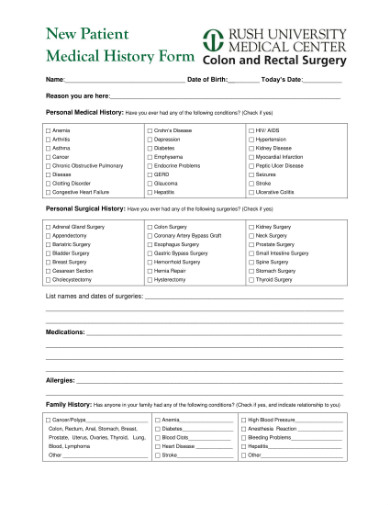7+ Medical Research History Examples
It is truly a man’s world, in the sense that most of our scientific development are meant to benefit us. The domain of medical research best exemplifies this. In the past millennia, we have seen significant progress that, at the very least, extended the human life span. Research is not alone in improving our quality of life. Healthcare providers and medical researchers work together in remodeling human health.
Medical research is our mechanism to address health-related questions—may they be about diseases or health care improvement. There are different approaches to this type of research, depending on the queries we want to answer. We didn’t always regard medicine as a science. The early part of the medical research timeline was filled to the brim with superstitions and rituals to ward off evil elements. Like any other area of research, medical research had undergone several events that cemented its role in the improvement of public health.
Annals of Medical Research
Before healing was considered an actual science than voodoo, people have already been applying therapeutic knowledge. In the ancient world, people believed that diseases were punishment for incurring the wrath of the gods. To appease the deities, people performed rituals and offered sacrifices. They incorporated incantations and chants in the preparation of herbal concoctions. Their healing methods were mainly religious ceremonies and mysterious, supernatural formulas. The idea was when they wield the power of the gods, they can expel the elements causing the diseases.
Several radical thinkers of their time diverged from these beliefs. They believed that vengeful deities didn’t cause sickness. These ideas did not appear out of the blue but from observation and studies. These people performed their investigations and found that the gods weren’t the ones to blame. These scholars detailed how they came up with their ideas, and soon, this way of looking at the body gained momentum. There were several theories regarding the cause and treatment of diseases.
Knowing how to diagnose and cure illnesses requires adequate knowledge of the human body. What people knew about the body was limited by the ethics and laws of the state. Human experimentation and dissection were outlawed. Our understanding of human anatomy and its processes were derived mainly from studies done on animals. We were limited in what we can know because these systems do not operate the same way humans do. The old views in medicine were held for years until the errors could no longer be ignored. If we wanted to understand the human body, we need to study the actual human body.
No field exists in a vacuum, and medical research is no exception. This interactive relationship can be exemplified by Louis Pasteur’s germ theory of diseases. Pasteurization or heating milk and substances were a revolutionary method in the wine, and later milk, industries. It extended the shelf life of products, at the same time improving the quality. The principle was that microorganisms are causing the quality deterioration of wine. Pasteur applied this idea for human diseases in the sense that microorganisms were causing illnesses in people. This idea is still central to medical science today.
Although Louis Pasteur’s germ theory led to the discovery of vaccines for chicken cholera, anthrax, and rabies, modern vaccination goes back to 1798 when Edward Jenner developed the smallpox vaccine. He injected an inactive version of cowpox to a boy. This made the boy immune to smallpox. Because smallpox vaccination became mandatory, by 1979 smallpox was eradicated from the world.
However, vaccines against every disease aren’t possible. Other infections have to be treated as we encounter them. Although that practice has been with us since ancient times, we didn’t know the cause of the infections. Our treatment would be a catch-all method, and not specific to the culprit microbes. Eventually, scientists observed that certain bacteria react negatively to some substances. But, the material did not harm other cells. We have discovered antibiotics, and the first modern antibiotic was for the treatment of syphilis.
Our understanding of human health goes as far as the available information and technology can take us. Even though modern medical research started after the Industrial Revolution, we can observe the spike of research development in the latter parts of the timeline. Advances in technology have made it possible for faster research progress that wasn’t possible in the past. In 1869, Friedrich Miescher identified the DNA. By 2003, scientists have decoded the human genome. We have come a long way.
There is no one way to answer every question. As medical research continues to improve, multiple research methodologies have come to light. Instead of traditional clinical trials, scientists have made use of patient records to generate new information. The breast cancer cure Herceptin was a product of this method. Medical records have become more than just hospital files. We can make use of several published or consented information that will help answer our inquiries.
A Ready Resource Trove
There are basic, clinical, and epidemiological research, and there are existing literature-based studies. The former three are useful in providing specific and scientific information, but they are also limited by several technical, feasibility, and ethical considerations. Information-based studies are a pragmatic approach. They can yield data that are not immediately available from other methods. They offer real-world lenses, unlike controlled experiments.
1. Patient Medical History Form
2. Medical History and Screening Form
3. Health History Form
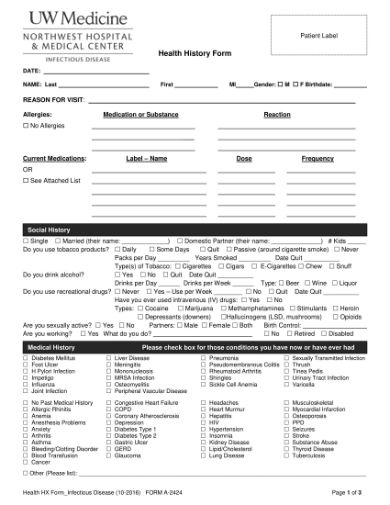
nwhospital.org
4. Women Medical History Form
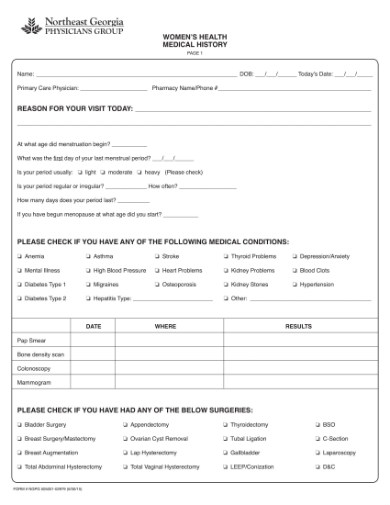
ngpg.org
5. Male Medical History Form
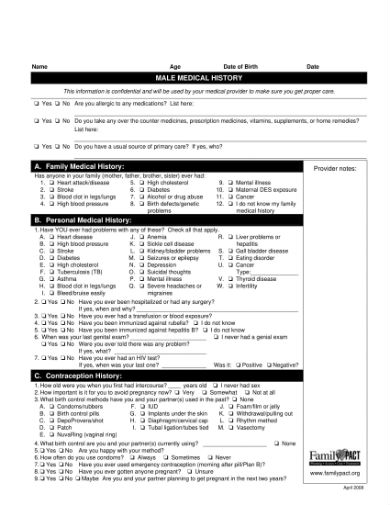
uaii.org
6. Pediatric Patient History Form
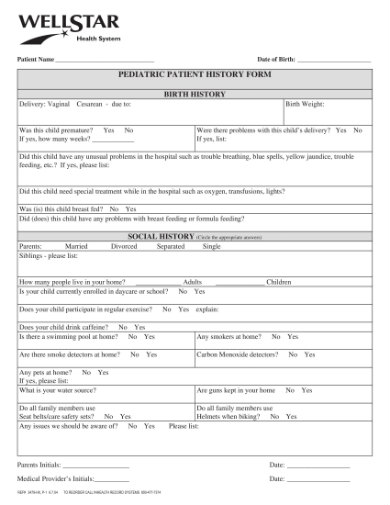
wellstar.org
7. Patient History Form
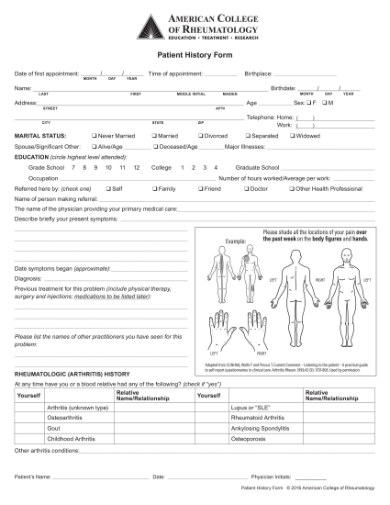
rheumatology.org
8. Comprehensive Patient History Form
The Wanted Synergy
One of the ways that healthcare providers can contribute to medical research is by providing the needed data for health-related investigations. Medical records are a good source of data for case studies, as well as epidemiology, health services, and public health research.
1. Saving lives since ’99
Aside from relaying relevant information for a study, a compilation of medical records can also be a database that contains life-saving data for future reference. This is exactly why the United Network for Organ Sharing (UNOS) was created. It catalogs data for organ transplants. Patients are listed in order of priority for the procedure. Since its creation in 1999, the database has recorded all transplant surgeries details to this date. This is a big picture of how far keeping up-to-date medical records can take us.
2. This is private property
With the advances in medical research brought by available information made available medical records, there is a gnawing concern in public with regards to their privacy. Although the government and research councils established privacy policies, the unconsented release of information is still allowed to some degree. This degree is subject to the amount of risk that the research can bring to the patient. One way to balance privacy and research productivity without violating ethics is for healthcare providers to remove identifiable information in the records before these are given for research.
3. He/She has to say “Yes”
Before health care personnel surrender the data requested by researchers, hospitals and clinics should see to it that patients approved for the release of their personal information. In the forms that patients fill in, healthcare providers can include a space where people can indicate if they consent information release for research purposes. Healthcare personnel should also ensure that the study provides minimal risk for the patients if the information is disclosed to the researchers. Medical ethics should be reinforced. If possible, there has to be consent, even when the research doesn’t pose direct harm to the patients.
4. A win-win proposition
To benefit both researchers and patients is for healthcare providers to establish a computerized database for easy storage and retrieval for patient information. Per request, concerned institutions can transmit and receive the data electronically. Personnel will make fewer mistakes in the input of data. Databases are also more secure and protected than paper versions of the medical records. Patients, knowing that their data is secured, will be supportive of medical research and will consent for the release of some of their information.
Arguably, medical research started to take off when people began to question the supernatural explanations in medicine and the human body. Science back then was limited by the available information and technology, as well as the society’s acceptance of a practice. This limitation may justify how the then genius methods and reasoning are deemed archaic and outdated to even be considered today. Several tomorrows after, some of our best medical practices today may leave future researchers scratching their heads. As long as we continue the work that was started before us, we’re bound for the right direction.



